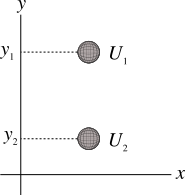Potential energy is defined as the energy due to position of a system that supports it, for example the gravitational potential energy in Earth-mass system, electric potential energy in Field-charge system, elastic potential energy in spring-mass system. You'll soon see that the potential energy is not a single entity but a shared property.
We always do work and that work we do becomes the energy such as kinetic and potential energies. The different terms are used because they are different types of energies or their dependence is different. The work we do is converted to energy like we did work and it is turned into the kinetic energy, but the same work we do can be turned into a different kind of energy called potential energy.
Let's take an example of gravitational potential energy here. We know that the weight of a body is the downward force of gravity. A ball is released from a particular height in gravitational force of magnitude \(mg\) where \(m\) is the mass of the ball. The work done by the gravitational force between the heights \({y_1}\) and \({y_2}\) is,
\[\begin{align*} W &= -mg({y_2} - {y_1})\\ {\rm{or,}}\quad W &= mg{y_1} - mg{y_2} = U_1 - U_2 = -(U_2 - U_1) = -\Delta U \tag{1} \label{1} \end{align*}\]
where \(U_1\) and \(U_2\) are the gravitational potential energies at height \(y_1\) and \(y_2\) respectively. Therefore, the gravitational potential energy \(U\) at any height \(y\) is \(mgy\) which is the work done by the gravitational force from height \(y\) to \(y=0\). Notice that the initial potential energy \( U_1 = mg{y_1}\) is the total work done by the gravitational force from \(y = {y_1}\) to \(y = 0\) and this is similar for the final potential energy \(U_2 = mg{y_2}\). So the potential energy is in fact the work done.

Note that \(\Delta U\) is the final potential energy \(U_2\) minus the initial potential energy \(U_1\) but the work done by the gravitational force is the initial potential energy minus the final potential energy. The ball in Figure 1 falls under the action of gravity and therefore \(y_1 > y_2\) and the work done by the gravitational force is positive as it should be. The Equation \eqref{1} tells us that the work done by the gravitational force is the negative of change in potential energy.
Here in the example of gravitational potential energy, you can understand that it is a shared property of the Earth and the mass of the body. In case of kinetic energy, the key property was the speed of the body of its own and not dependent on anything else; the speed and mass were united acting like a single entity. Here the force due to which the energy exists is the gravitational force and this force is due to the Earth without which no energy would be possible, and the mass of the body itself because if no mass no force and no energy. So, when we call potential energy we always think it as the shared property of a system that supports it.





